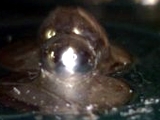|
|
|
|
|
|
|
|
|
|
|
|
| Ask the Experts | |||||||
|
|||||||
|
January 19, 2011 - Updated January 17, 2011 - Originally Posted Soldering Quality & IPC Standard?
D. H. |
|||||||
| Expert Panel Responses | |||||||
|
The criteria for lead protrusion requires the lead is visible in the solder joint as defined in Section 7.3.5 of IPC-A-610 Rev E. In looking at the picture provided the leads are not visible therefore a decision needs to be made concerning that criteria. I would not accept the product as shown. Now the acceptability of double soldering those pins is very questionable, as it appears as very poor workmanship, in that it appears that not enough heat was applied in the secondary soldering operation to completely form a homogenous solder joint with the existing solder alloy in the joint. So overall impression is poor workmanship and a non acceptable condition as the lead is not visible in the solder joint.
Vice President, Technical Director EPTAC Corporation At EPTAC Corporation, Mr. Lambert oversees content of course offerings, IPC Certification programs and provides customers with expert consultation in electronics manufacturing, including RoHS/WEEE and lead free issues. Leo is also the IPC General Chairman for the Assembly/Joining Process Committee.
Here are my thoughts. Not sure if it is valid, as it based upon minimum information that is provided. Looks like during the first soldering pass, there was non-wetting, which resulted in the solder forming the ball. The possible reasons for this could be improper flux density (not providing adequate fluxing), insufficient preheat and activation of flux, and possibly insufficient time during preheat and reflow during the first try. When the second soldering cycle is done, there is adequate wetting to the pads and also to the ball due to the cleaning of the surface by the flux from the previous trial and also the second trial. This in my opinion will not conform to/satisfy the IPC standards.
President inspīre solutions LLC Bjorn Dahle is the President of inspīre solutions LLC. He has 20 years experience in the electronic manufacturing industry with various manufacturing equipment companies covering pick & place, screen printers and thermal process management.
A prerequisite of any solder joint is that it must be homogenous and, regardless of the IPC standard, this type of solder joint is not acceptable. The two solder masses may not be metallurgically fused with one another and this could lead to premature failure of the solder joints under environmental stress. Guidance can be gleaned from Section 5.1. of IPC-A-510D.
Principal Engineer - CMA Lab BAE Systems Bryan Kerr has 35 years experience in providing technical support to PEC assembly manufacturing. His experience ranges from analysis of materials and components to troubleshooting and optimizing, selecting reflow, cleaning, coating and other associated processes.
|
|||||||
| Submit A Comment | |||||||
|
Comments are reviewed prior to posting. You must include your full name to have your comments posted. We will not post your email address. |
|
Free Newsletter Subscription
Circuitnet is built for professionals who bear the responsibility of looking ahead, imagining the future, and preparing for it. Insert Your Email Address |
|
|
|
|
|
|
|
|




